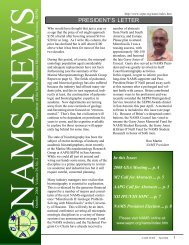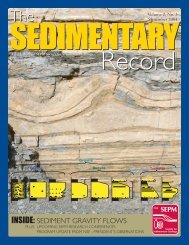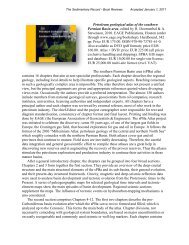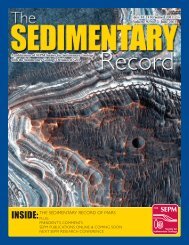PDF of contents and abstracts - SEPM
PDF of contents and abstracts - SEPM
PDF of contents and abstracts - SEPM
You also want an ePaper? Increase the reach of your titles
YUMPU automatically turns print PDFs into web optimized ePapers that Google loves.
ABSTRACT: Recent work indicates that most modern continental sedimentary basins are filled primarily<br />
by distributive fluvial systems (DFS). In this article we use depositional environment interpretations<br />
observed on L<strong>and</strong>sat imagery <strong>of</strong> DFS to infer the vertical succession <strong>of</strong> channel <strong>and</strong> overbank facies,<br />
including paleosols, from a hypothetical prograding DFS. We also present rock record examples that<br />
display successions that are consistent with this progradational model. Distal DFS facies commonly<br />
consist <strong>of</strong> wetl<strong>and</strong> <strong>and</strong> hydromorphic floodplain deposits that encase single channels. Medial deposits<br />
show larger channel belt size <strong>and</strong> relatively well-drained soils, indicating a deeper water table. Proximal<br />
deposits <strong>of</strong> DFS display larger channel belts that are amalgamated with limited or no soil development<br />
across the apex <strong>of</strong> the DFS. The resulting vertical sedimentary succession from progradation will display<br />
a general coarsening-upward succession <strong>of</strong> facies. Depending on climate in the sedimentary basin,<br />
wetl<strong>and</strong> <strong>and</strong> seasonally wet distal deposits may be overlain by well-drained medial DFS deposits, which<br />
in turn are overlain by amalgamated channel belt deposits. Channel belt size may increase upward in the<br />
section as the DFS fills its accommodation. Because the entry point <strong>of</strong> rivers into the sedimentary basin is<br />
relatively fixed as long as the sedimentary basin remains at a stable position, the facies tracts do not shift<br />
basinward wholesale. Instead, we hypothesize that as the DFS fills its accommodation, the<br />
accommodation/sediment supply (A/S) ratio decreases, resulting in coarser sediment upward in the<br />
section <strong>and</strong> a greater degree <strong>of</strong> channel belt amalgamation upward as a result <strong>of</strong> reworking <strong>of</strong> older<br />
deposits on the DFS. An exception to this succession may occur if the river incises into its DFS, where<br />
partial sediment bypass occurs with more proximal facies deposited basinward below an intersection<br />
point for some period <strong>of</strong> time. Three rock record examples appear to be consistent with the hypothesized<br />
prograding DFS signal. The Blue Mesa <strong>and</strong> Sonsela members <strong>of</strong> the Chinle Formation at Petrified Forest<br />
National Park, Arizona; the Tidwell <strong>and</strong> Salt Wash members <strong>of</strong> the Morrison Formation in southeastern<br />
Utah; <strong>and</strong> the Pennsylvanian–Permian Lodéve Basin deposits in southern France all display gleyed<br />
paleosols <strong>and</strong> wetl<strong>and</strong> deposits covered by better-drained paleosols, ultimately capped by amalgamated<br />
channel belt s<strong>and</strong>stones. In the Morrison Formation succession, sediments that represent the medial<br />
deposits appear to have been partially reworked <strong>and</strong> removed by the amalgamated channel belts that show<br />
proximal facies, indicating that incomplete progradational successions may result from local A/S<br />
conditions. The prograding DFS succession provides an alternative hypothesis to climate change for the<br />
interpretation <strong>of</strong> paleosol distributions that show a drying upward succession.






